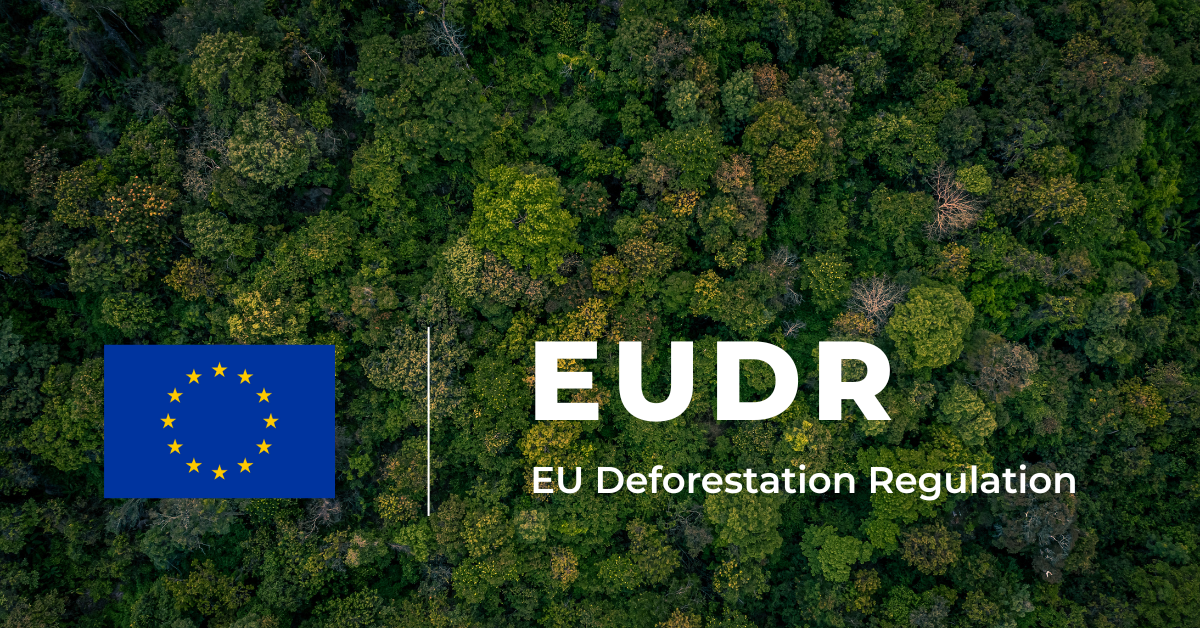The EUDR and Its Implications
In 2023, the European Union adopted the EU Deforestation Regulation (EUDR), a landmark piece of legislation designed to curb the EU’s contribution to global deforestation. The regulation targets seven commodities closely linked to deforestation: cattle, cocoa, coffee, palm oil, rubber, soy, and wood, along with many products derived from them. From late 2025 onwards, companies need to prove that these goods, whether placed on the EU market or exported from it, are deforestation-free and legally produced.

The timeline for compliance will be quickly implemented. Large companies have to be ready by 30 December 2025, while small and medium-sized enterprises (SMEs) have until 30 June 2026. Regardless of size, all companies falling under the scope of EUDR will be expected to conduct some form of due diligence: tracing commodities to the precise plot of land where they were grown or raised, collecting geolocation and time-of-production data, and verifying compliance with local laws.
Non-compliance could result in more than just regulatory action. Products may be seized at the border, companies may face significant fines of at least 4% of the total annual turnover in the EU, and reputational damage could follow if violations are made public. EUDR compliance is therefore not just a legal obligation—it’s a business risk management issue.
The Complexity of Supply Chain Due Diligence
While the regulation itself is clear in its ambition, implementation on the ground is far from straightforward. At the heart of the challenge lies the task of supplier engagement. Companies must reach deep into their supply chains, collecting detailed information from potentially thousands of producers, many of whom are located in regions with limited digital infrastructure, regulatory capacity, or awareness of EU requirements.
Engaging suppliers is rarely a one-time task. It involves ongoing data collection, education, communication, and verification. Businesses need to ensure that their suppliers not only understand what is expected of them, but are also capable of providing consistent and accurate data in a format that can be audited. For firms sourcing from high-risk regions or from smaller producers, this can quickly become a resource-intensive undertaking.
What’s more, the burden of assessing risk by region, product type, and supplier practice often falls on already stretched ESG or compliance teams. Without the right systems in place, the process risks becoming reactive, fragmented, and unscalable.
A Scalable Solution for Supplier Engagement
Greenomy supports companies in navigating these challenges by offering a supplier engagement system that is both practical and scalable. Rather than relying on email chains and spreadsheets, our approach integrates customisable ESG questionnaires with automated data collection tools. Suppliers can respond directly through structured forms, while companies gain real-time visibility into response quality, gaps, and risk levels.
Artificial intelligence plays a supporting role by reviewing supplier documents in local languages and flagging inconsistencies or missing data. This reduces manual review time and improves accuracy. The outputs—ranging from dashboards to downloadable reports—are designed to be audit-ready from day one.
Our system doesn’t just collect data; it translates it into insight. By generating supplier risk scores based on region, commodity type, and reported practices, we enable companies to prioritise their attention and escalate engagement where it’s needed most.
Beyond EUDR: A Foundation for ESG Compliance Across Sectors
Although originally developed to support EUDR compliance, Greenomy’s supplier engagement tools have broader applications. Many industries face growing pressure to improve supply chain transparency and meet ESG standards—from voluntary frameworks like LEED or Fairtrade to mandatory regulations such as REACH or the Corporate Sustainability Due Diligence Directive (CSDDD).
In the agri-food sector, our tools can help companies document certification status and verify the origin of raw ingredients. In construction and real estate, they support audits on labour practices and environmental compliance. For the textile industry, they enable traceability from cotton fields to retail shelves, and in manufacturing, they facilitate hazardous substance declarations and safety reporting.
The key strength of Greenomy’s approach lies in its flexibility. The same infrastructure built for EUDR can be adapted and reused, making it easier for businesses to respond to future regulatory demands and sustainability goals.
Getting Ahead of the Curve

For companies dealing in EUDR-covered commodities, time is of the essence. Mapping the supply chain, identifying gaps in data, and setting up engagement mechanisms cannot wait until the last minute in your reporting journey. What’s needed is a structured, proactive approach—one that integrates compliance into everyday operations rather than treating it as an afterthought.
Greenomy helps businesses put that structure in place. By combining deep regulatory knowledge with ready-to-use digital tools, we make it possible for companies to approach EUDR compliance with clarity and confidence.
For businesses seeking not just to comply, but to lead on supply chain sustainability, supplier engagement is the place to start. And with the right partner, it doesn’t have to be a burden. For more information about how Greenomy can help you, get in touch with our teams.
























.png)





.png)
.svg)
















